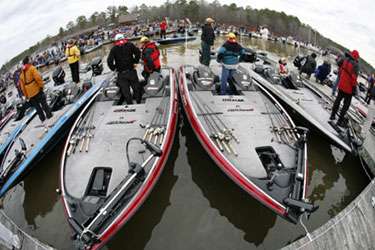
Bass rigs are expensive. Taking care of them is a matter of common sense. That same common sense tells us there’s a right way to do it and a wrong way. This two-part series will look closely at the right way. Part I will detail procedures for maintaining the hull. Part II will do the same for the motor.
Part I: The Hull
“Regardless of whether you store your boat inside or outside, water’s the big thing you’ve got to deal with,” says Ben Jarrett, national sales manager for Skeeter Boats. “When water freezes it exerts enormous pressure. That pressure can cause big problems. And, even if your rig is in a heated environment, water can cause corrosion, mold and mildew damage. You’ve got to get rid of it.”
Tips for protecting your boat’s hull
1. Drain the livewell and related hoses. Take the hoses off if necessary. Towel blot any water in the bottom of the livewell, especially around the fittings and screens. “Even a tiny bit of water freezing around a fitting or a drain can cause problems,” Jarrett says. “Dry fire your livewell pumps to make sure you’ve got it all.”
2. Remove everything from the cooler and dry it thoroughly.
3. Last — water drains down — remove every bit of moisture from your sump system. Check the battery compartment and under the deck, down by the transducer and in the lowest part of the hull. Remove and dry all hoses. Again, dry fire the pump to make sure you got it all.
4. Open all the compartments and let them air dry if possible. Towel dry the hinges and any other hardware. Then close the lids tightly.
5. Make sure everything liquid is removed from the boat. This includes attractants, aerosol cans and sodas.
6. Apply a good coat of marine wax to the hull.
7. Make sure the boat is covered properly. This means using a cover that fits and installing it according to the manufacturer’s instructions. (This may require a radical departure from standard operating procedure for most of us — reading the instruction manual.)
In addition to drying the boat it’s important to protect it from animals. Block all entrances to the boat. This includes holes in the transom where cables and hoses enter the boat from the motor or the jack plate. Cats, squirrels, rats and mice can destroy a boat in a matter of days.
If your boat is stored inside, consider winter storage as a maintenance opportunity. In addition to the above procedures, Jarrett recommends the following:
More tips for safe storage
1. Check lug nut torque, apply tire dressing and consider balancing the tires and wheels. This is a good time to replace tires, if necessary.
2. Lubricate the hitch.
3. Check the brakes.
4. Clean and detail your boat thoroughly. Use a tooth brush on the lids, around the backs of the lips and in the hinges. Remove oil and grease from the battery storage compartment. Apply lubricant as necessary.
5. Keep all the compartment doors open to allow for ventilation. (Do this only if there’s no animal problem in the building.)
“Your boat can’t be too dry, too clean or too well-maintained,” Jarrett summarizes. “Doing these things right this winter will prevent damage, save you money, protect your investment and make a big difference in the spring when you want to go fishing.” See Winterize your boat, Part II.
Originally published December 2008




